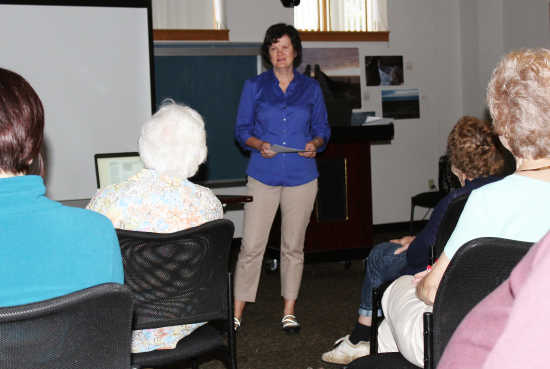Small towns big deal when it comes to historic preservation

I’ve seen it all in a small town,
Had myself a ball in small town ...
Residents of small towns like Bainbridge, Cloverdale, Roachdale and Russellville really don’t need “Small Town” Hoosier balladeer John Mellencamp to document their feelings about small towns.
Oh, those small communities.
Rose Wernicke has also seen it all in a small town. Working as a historian to assist the Heritage Preservation Society (HPS) of Putnam County in achieving National Register of Historic Places status for those Putnam small towns, she has spent considerable time in all four communities, walking the streets, camera and notebook in hand, shooting pictures of significant and noteworthy architecture and documenting what makes them historic and special.
But it wasn’t as easy as it might sound. After all, this in 2017, not 1917.
Wernicke said she was questioned thoroughly and often about what she was doing there. Had the police called on her in one instance. And even had a woman take her picture for future reference (can you say mugshot?) despite Wernicke explaining what her presence was all about.
“But it’s been so much fun finding out a lot of these stories,” Wernicke offered. “People got very curious though why someone with a clipboard and a camera was walking around.”
Despite all that, she came away with a comprehensive report about the towns and their historic structures.
Wernicke detailed special finds from her research in preparing the nominations to the National Register of Historic Places.
“It’s all about the buildings,” she told a small Putnam County Public Library audience on an extremely rainy morning.
For instance, she found Italianate commercial construction, such as the Cloverdale Hardware building constructed sometime in the 1870s-1880s, late Gothic revival churches from the 1920s in Bainbridge and Roachdale, along with Greek revival residences that include an 1860 Bainbridge cottage and an 1853 Russellville home.
And then there’s the octagon house on the west side of U.S. 231 in Cloverdale built in the late 1860s or 1870s.
“There are only a couple of those left in Indiana,” Wernicke said, noting that the octagonal design is meant to approximate a circle helping create better airflow and increased efficiency.
A young couple has been renovating the Cloverdale octagonal house, Wernicke reported, adding that it is sometimes referred to as the Thomas Corn house and noting that a Cunningham family is also known to have lived there.
Wernicke also came across classic Queen Anne homes, including two right across the street from each other in Roachdale. That style morphed into the gable-and-wing house of which there are a whole line along Lafayette Street in Cloverdale, she noted.
Architecture and transportation drive the train when it comes to making the National Register, Wernicke said.
And Roachdale and Russellville certainly have a well-documented history of railroad influence.
Roachdale grew up early along the railroads, Wernicke said, with Elijah Grantham jumping on the chance to market building lots once a second railroad went through the area in 1880.
“Railroad was king,” Wernicke assured.
So much so, in fact, that two sections of Russellville are still apparent. There’s “new Russellville” in the area where the railroad went through and the old depot still stands, and “old Russellville,” where Wernicke said townspeople once hoped to create the seat of a new county (taking sections out of Putnam, Parke and Montgomery counties along the way).
“They lost by one vote,” longtime Russellville resident Darrell Wiatt advised from the audience.
Wiatt also related that some of his relatives were from the Blakesburg area (west of Fincastle), which he said was the second largest town in Putnam County during the 1830s.
“But the railroad didn’t go through there,” he noted, adding that Carpentersville was also reportedly larger than Roachdale in the late 1880s before the railroad went through Roachdale.
Wernicke said her travels also took her to the Thomas McGan home in Russellville, presumably the oldest house in Putnam County. It was built in 1853 on land purchased in 1830, and -- incredibly enough -- the same family (Sinnet) owned it until 1992.
The home was also believed to have been used on the underground railroad.
The McGan site also includes an 1850s log barn which still stands inside a 1950s-era barn.
Meanwhile, Bainbridge grew up around the road between Rockville and Danville which later became U.S. 36.
“In the teens, it became known as the ‘Ocean-to-Ocean Highway,’” Wernicke said. “In the 1930s it was estimated that 120 cars an hour came through Bainbridge on that road.”
But when it became U.S. 36, the roadway was moved a block north in Bainbridge, away from Main Street.
“The change in the road,” she said, “definitely affected the way the town looks.”
Wernicke and Putnam HPS President Phil Gick reminded residents that the National Register is “first and foremost, an honorary designation” that can make an area eligible for grants.
Private property owners, however, can still do what they wish with their properties, even though they might be included in the historic area. A house or other building can even be torn down.
However, that changes if grant funds are involved in renovating and restoring a building, they noted.
“I don’t think people know their homes are in districts and are contributing structures,” Gick said.
Wernicke has her small-town applications all written but the state still has to do “what they call substantive review,” she said.
“If these are approved,” Gick said, “these smaller communities may find some opportunities available to save some of these buildings.”
He reminded that funding for building renovations in Greencastle would not have been available had certain areas not already been designated as historic districts when the Stellar Grant became available.
